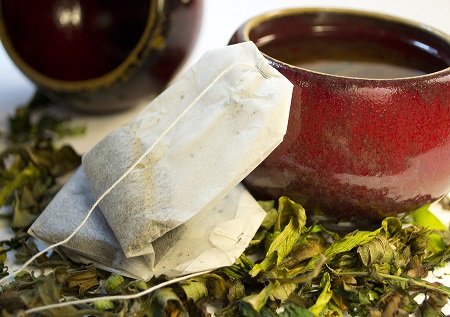Did you know that there are chemicals sprayed on your tea bags? Here are the best ways to drink tea and get all the health benefits.
Whether you enjoy a hot cup in the winter or an ice-cold glass in the summer, anytime can be tea time. From black to white, red to green, tea is a popular drink that has found its way into many rituals in virtually all cultures around the world.
By now, most of us know that many of these drinks have important benefits.

True teas are made from leaves of tea plants, or Camellia sinensis, which originated in China. Black, green and white teas are rich in antioxidants, as is rooibos, which is actually not a tea at all, but a legume from South Africa. Rooibos tea is actually a ’tisane.’ and infusion made from the leaves, flowers, seeds and/or roots of a tremendous variety of plants, such as mint and hibiscus (with or without rose hip), sassafras and ginseng. Interestingly, the only thing all these plants have in common is that they are not Camellia sinensis.
Many cultures have ancient traditions of drinking teas and tisanes for medical benefits, even though few randomized clinical trials support this use. The main reason appears to be that the strength of the active ingredients varies according to growing conditions and soil fertility, to name only two confounding factors. However, in Chinese Traditional Medicine, a recipe of hawthorn and pu-er (fermented and often aged tea) is used to reduce high blood fat (elevated triglycerides) levels. Catnip and chamomile ‘teas’ calm, while pine tea high in vitamins A and C, and St. John’s wort tea has been used as an antidepressant. In addition to its antioxidant properties, green tea may boost your metabolism, aiding weight loss.
But if your favorite brew is in a teabag, there’s some bad news: that bag is likely to be coated with epichlorohydrin—a known carcinogen that is particularly active in hot water.
The good news is, epichlorohydrin is also soluble in water-—so rinse the bag well in room-temperature water, and the epichlorohydrin will dissolve away without dangerous activation. Then you can make tea according to the package instructions or your particular taste, without the worry.
Recently, teabags have begun to be produced from plastics like PVC and food-grade nylon as an alternative to the paper tea bags. Unfortunately, these teabags begin breaking down and leaching chemicals into water at temperatures well below those used to make tea. And many teas and tisanes, even high-end, expensive ones, contain pesticide residues and flavoring agents.
The best way to make a tea or a tisane?
- First, buy loose-leaf organic: loose leaf tends to have higher levels of their antioxidants and other health-boosting compounds, and organic means lower risk of toxic chemical ‘cides.
- Second, place the leaves in a teaball or a strainer and brew your beverage in a cup or a pot.
- Third, savor the aroma and sweeten with your favorite sweetener. (To learn more about which sweeteners are best for your health and weight-loss goals, click here.) Drink with that special someone, a friend or purring cat, your favorite book or just as a fast break from a hectic day.
For an incredibly refreshing drink that’s perfect for these last days of summer, try our Slimmer’s Tea. It takes about 5 minutes to make and it’s full of citrus flavor and packed with antioxidants and metabolism-boosting phytochemicals.




11/17/19 My question concerns buckwheat honey. Is that an ok product (1 tsp/day) or not? Sold in health food stores in my area but wondering if pesticides were used on those plants. Thanks.
Hi, JeannePhotos. Buckwheat honey is fine. Try organic if you are worried about pesticides.
Hi I’m new to the club, I’m 61yrs of age & have just been diagnosed with early stage breast cancer, will this work for me please Regards Linda
Hi, Farishta. Triangular bags are usually plastic, and so there is nothing to rinse off – the entire bag may be a problem when it hits heat.
Thank you ossi-sharon. I normally have Manuka honey active 10.So triangular bags must be abandoned? Did not understand why rinsing them will not help.Will be grateful if you can shed more light. Best Wishes.
Hi, Astanton. K-cup types of drinks aren’t really recommended on a regular bases, though once a day is fine, of course. If you can get a teaball and loose tea, that would be best.
I drink a lot of tea through my Keurig, in particular the Pure Peppermint and the Green Tea. Is this okay?
Hi, Dianna. Organic tea is better than non-organic in general, but to the best of our knowledge, the bags are not always quite as safe. Check the box or the tea company’s website, and if nothing is mentioned, I would suggest to rinse the bags in cool water (or use loose organic tea).
teas marked organic do we need to rinse them.
lovely hurling, very interesting read. learned a lot
Very interesting article. I learned some new information about tea. Thanks
Hi, Davis. Health-oriented stores are the best place – this includes Whole Foods Market and Trader Joe’s.
Do you know of the best places to get loose leaf tea? My sons drink a lot of cold tea, trying to change their habits this would be a good one to change.
Hi, Gayle Guillen. Just run them under tepid water (not hot!). We generally recommend loose teas, preferably organic (these are to be used in a tea ball or mini-basket).
How do you rinse tea bags? And what are some names of teas that you would recommend? I know I will need a lot of help with all this because there’s a lot that I don’t know about how things are processed.
Thank you Ossie-Sharon. Until reading the article, I would’ve never thought about what the machine tea packets are made of. I enjoy some of the teas. I like the convenience of just placing them in the machine and getting a nice up of tea.
This is a fascinating explanation: I’ve often wondered about the effect of a teabag…are we trading convenience for something that not only filters the flavor, but offers chemicals as an unwelcome replacement? Thanks for the facts, Trim Down Club. You always inspire!!
Hi, Carol. Organic black tea is great – it has some of the same benefits as green tea, including “fat-burning”. Milk in green tea is absolutely fine.
Is green tea the only fat burning tea ? Can I have milk in green tea ?
Is organic black tea a healthy tea?
That is news to me about rinsing teabags; I will start that now. Thanks.
About sweeteners, a MUCH better alternative is to wean yourself off them completely; it took me six weeks to stop adding sugar to anything (in my case cereals, tea and coffee); they actually taste better without sugar!
Now I am trying to avoid products with sugar already in them.
Hi, jbhunt. Just hold the bag under running room temperature water (not hot!), until a couple of seconds after it is already soaked.
How do you rinse a tea bag before steeping?
Hi, Santeelady. Since the materials are considered a trade secret, all I can say is that they are foil, and so probably don’t need to be coated.
Hi, Laura. Unfortunately, yes. It’s never too late to start rinsing before steeping!
Does Celestial Seasonings tea spray their tea bags too? I’ve been drinking their tea for decades!
I didn’t know that tea bags needed to be rinse first. Now, I’ll do that. Are the tea packets used in machines like Flavia good for you? I have one of those machines and enjoy drinking tea all year round – even iced tea.
Hi, MazT. That’s definitely OK.
I love Chai tea with a little lite milk….is that ok?…Marilyn.
Hi, Farishta. Use of honey depends on how processed it is, and how much. If you use a teaspoon a day it’s fine, and of course, raw honey is the best option. You can read more about sweeteners in our article “The Best Way to Sweeten your Tea” (https://www.trimdownclub.com/the-best-way-to-sweeten-your-tea-2/).
With regard to the triangular tea bags, there are some concerns that the material from which they are made may be toxic when heated, and rinsing will not make a difference here.
Is honey a safe and healthy sweetener for weight loss?
What about Liptons Morccan spicy mint tea infusion in triangle tea bags?It would lose flavour if tea bag is washed before infusion.
Hi, Rileyfamily. Coconut sugar is excellent, and Stevia usually is as well. Ironically, Stevia in the Raw is not very raw, and we would actually recommend something not quite as processed. When you have finished your “Raw” product, I would suggest looking for something with the “Sweet Leaf” label.
As for the tea itself, “sencha” or “gunpowder” are teas with great purity benefit, as is something called Wu Long Team by Okuma naturals that we particularly like (you can contact Customer Service for information about how to get this. Drinking green tea daily is absolutely fantastic, especially if you are interested in fat burning and enhancing your metabolism and health (including your skin).
Also I purchased some stevia in the raw and coconut sugar. Are either one of these ok to use in tea?
I bought a package of green tea cups to go in my Keurig coffee pot. There’s nothing special about it, but I need to know if any green tea is great for you?
Should I look for certain types of green tea?
Should I be drinking it daily?
Are there positives to it like fat burning? Metabolism? Skin? Just wondering…
I am English and therefore an avid tea drinker all my life. I agree that the best teas are made from leaves (loose tea) and not tea bags BUT every English person will tell you it is ESSENTIAL to make tea (teabag or loose tea) with BOILING water – (you will find an electric kettle in every English kitchen – unknown in most American kitchens). Boiling water has the added side benefit of killing off any carcinogens.
Hi, Rileyfamily. You definitely don’t have to be stuck with honey or sugar. You can read more about recommended sweeteners here: https://www.trimdownclub.com/the-best-way-to-sweeten-your-tea-2/, and make the choice that best suits you.
I’m at a loss for knowing what to put in my tea so that I’ll still enjoy it. I love Lipton caffeinated tea. My husband makes it by the gallon and will put up to four cups of sugar in it. What combination should I use that will keep it tasting great and have no nasty aftertaste?
Also, I do not like honey in tea-it does not taste good at all.
Hi, RayT. Yes, of course! If you use a lot of milk over the day, it would be best to count it into your day – 1 cup (8 fluid ounces or 240 ml) is equal to one protein + one carbohydrate.
Can I have milk in my tea?